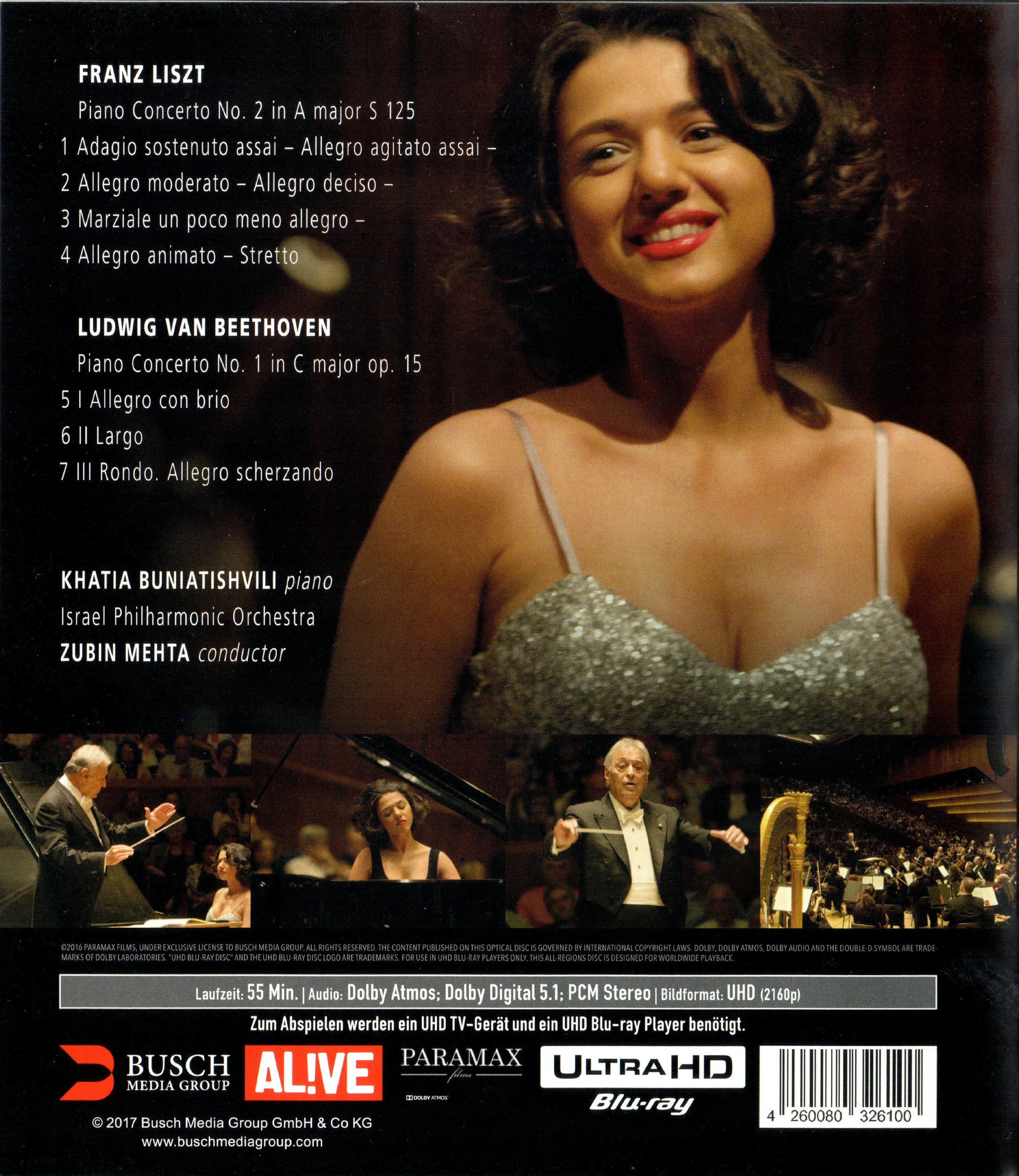




On July 4 and 6, 2015, Zubin Mehta conducted the Israel Philharmonic Orchestra in two concerts at the Charles Bronfman auditorium in Tel Aviv. On one night Khatia Buniatishvili performed the Liszt Piano Concerto No. 2. On the next night she played the Beethoven Piano Concerto No. 1. Videographer Christophe Boula was there to film Khatia's performances for Panamax. He must have been frustrated as he was unable to set up cameras at the back of the hall to shoot the orchestra and Khatia from normal angles of 4:00 to 8:00 o'clock. Most of his cameras were consigned to the sides and back of the stage (he did have one camera, probably hanging from a boom, that could shoot Khatia at the keyboard from about 7:00.)
Boula was told to make a DVD-style recording. But he had the capability of shooting something far better. I wonder if Boula knew at the time that his work would eventually result in the first fine-art recording ever to be published in 4K with High Dynamic Range? And did he foresee that the images he would record would nevertheless be crippled by odd defects in PQ and by weak video content?
Eventually, Boula's filming of Khatia's concertos were published in 3 forms: a DVD (which we will ignore), a 2K Blu-ray (which we bought and reviewed here in late June 2017), and in 4K with HDR (high dynamic range). We also bought the 4K/HDR version late in 2017, and at first we could not get it to play correctly in our HT. But after a comedy of errors (of the sort all too familiar to all early-adapters) we recently got it to play on our gear. We will cover both the 2K Blu-ray and the 4K/HDR versions in this story.
In the thumbnails above, you see (1) the front of the preliminary ("vorlaeufiges") or provisional package for the 4K/HDR version, (2) the final front of the 4K/HDR version, (3) the back of the final 4K/HDR version, (4) the front of the old-fashioned 2K Blu-ray package, and (5) the back of the 2K Blu-ray.
Both the 2K Blu-ray and the 4K/HDR discs have 5.1 Dolby Digital and Dolby Atmos sound. (Dolby Atmos is not bound to 4K—it can be played on a 2K disc if you have the right gear and speakers). Folks who worked on the sound included engineers Jiri Heger and Rafi Eshel, Dolby Atmos mixer Eric Chevallier, Atmos mix artistic director Mireille Faure (Soundways), and sound producer Amos Rozenberg. The package claims running time of 57 minutes; actual music on the disc runs 49 minutes, 42 seconds. Grade: D for the 2K Blu-ray title and B for the 4K/HDR version.
In the rest of this review, we will try to demonstrate the difference between the normal 2K Blu-ray video image and the 4K/HDR image. (Remember, all the other 4K recordings we have now of fine-arts shows are without HDR.) We will then consider the quality of the video content, which is, of course, the same for both discs. We will not discuss further the SQ on the 4K disc except to say that our gear guru, John Fort in Dallas, states that the sound recording standards in the 4K arena are higher than for 2K Blu-ray and that he can hear the improvement in sound quality on this 4K/HDR disc.
Image Quality
The screenshot next below is from 43 seconds into the Beethoven Piano Concerto on the 2K Blu-ray. Nice smile!
But compare the image above with the same shot below in 4K/HDR. There is a distinct improvement in image brilliance (ignore the blooming you see here which is not present in the HT).
Next below, we show you two more pairs of images with the 2K Blu-ray above and the 4K/HDR below:
You might wonder how we got these shots since there is no readily available software for consumers like us to play 4K/HDR material on a computer. Well, we did it the old-fashioned way with digital cameras including a Lumix DMC-LX5 and a LG V30 smartphone. The color and luminescence values in the digital camera images are a bit off and there is a slight but noticeable degradation from the image in our HT by the time these copies appears on the website. Suffice it to say that the real thing is distinctly nicer than what you see here.
There is, however, a problem with PQ in this 4K/HDR recording that is clear in the HT and also visible in the 3 HDR screenshots above. Here’s how Wonk Lewis Chang puts it:
“The new buzz word, HDR, is supposed to deliver more realistic picture by having a wider gamut of colors and a wider range of brightness and contrast. But I think that HDR advocates exaggerate it by comparing HDR to desaturated picture. As a results, many viewers expect HDR to be hyper-realistic or even super-natural (no-longer-natural). I would say the Zubin/Khatia concertos discs are in the no-longer-natural spectrum of things. I think the the contrast is too high and this ends up promoting many of the wrong things: blinding music sheets, shiny foreheads of bald and semi-bald men, lights in the auditorium which prevents people from tumbling down. But I think the producer screwed up even more in terms of color balance. The unnatural tinge in the whole stage and on human skins is so distracting, and further worsened by high contrast ratio. The whole thing just has an unpleasant look, even though HDR is doing its job by having brighter bright and darker dark. The HDR did not end up doing what it is supposed to do, by delivering more subtlety and more realistic picture. So, the viewer is forced to see both the artistry and distractions.”
With Wonk Chang’s comments in mind, we reach a preliminary conclusion: if bugs don’t creep in, 4K/HDR should give us a picture quality that is overwhelmingly better than DVD. For the last 10 years we have too often heard from consumers who couldn't see enough difference between DVD and 2K Blu-ray to cause them to switch to the newer technology. Marketing lore states that a new format must be 8 to 10 times better than the old to cause consumers to upgrade. Well, now with 4K/HDR we have 16 times more resolution. But perhaps even more important is the vast improvement (when done right) that HDR hopefully should be able to deliver across the screen in variation of luminosity and enhanced color accuracy.predict he will do better next time.
The folks at www.classicalvoice.org have picked the 4K/HDR version of subject title as one of the 9 best classical music Blu-rays available today. Jeremy Nicholas reviewed the 2K Blu-ray disc in the March 2017 Gramophone at page 29. He says watching Khatia is as thrilling as hearing her, and neither the lipstick nor the hair (with a life of its own) deters him. But the visual content causes problems for Nicholas. He states, "Khatia is the only thing worth watching. I lost count of the times the director cut away [from Khatia] at an inappropriate moment, losing the tension, focusing on the wrong section while the piano part was the musical center of attention." Oh dear, this sounds like DVDitis, doesn't it!
I ran Wonk Worksheets on both the Liszt and the Beethoven. Both videos flunk the all-important pace test with average clip lengths of 6 seconds or less. Most of the shots of Khatia are unrealistic because so many angles of her are from the rear of the stage. There are too many conductor shots, and there is not a single whole orchestra shot on the entire disc. We therefore diagnose a significant case of DVDitis.
You can tell from the screenshots above how dark the images are on the 2K Blu-ray disc. It seems as if the 4K/HDR recording was processed as a 2K Blu-ray with much of the luminescence of the original recording missing. This would be a bit like filtering out of a sound recording most of the sound information with a frequency higher than, say, 2500 Hz. The drab 2K video images cause us to reduce our grade from A to B. Our diagnosis of DVDitis requires us to further reduce the grade to D. You would not want to buy this 2K Blu-ray unless you have a special reason.
Because of the DVDitis, there would be a similar grade reduction for the 4K/HDR version from A to C. Thanks to the brave attempt to provide 4K/HDR images, we increase the grade to B. But the PQ problems described by Wonk Chang keep us from further upward adjustments. If you are an early adapter, you can cheerfully buy the 4K/HDR out of solidarity.
Here’s a trailer from Paramax Films:
Click below to buy the 2K Blu-ray:
OR
Now click below to buy the 4K/HDR disc:






